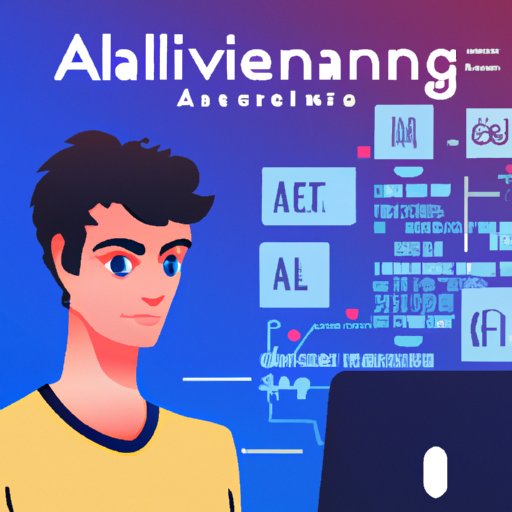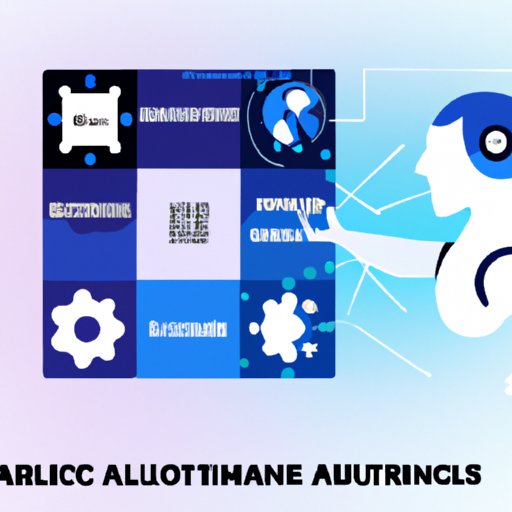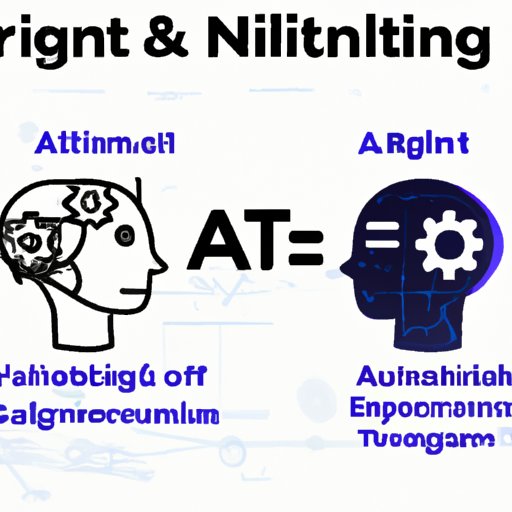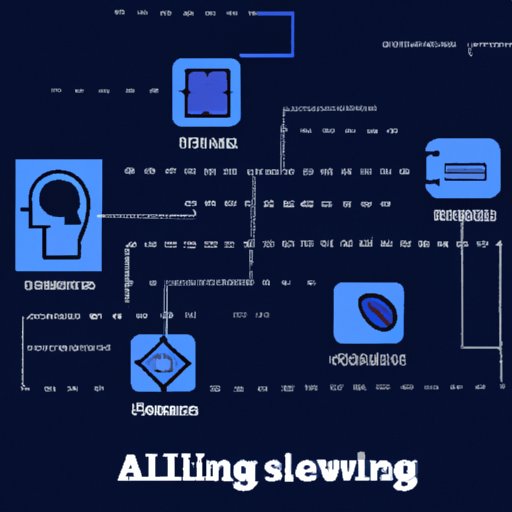Introduction
Artificial Intelligence (AI) is a rapidly evolving field of computer science that focuses on creating machines capable of performing tasks that would typically require human intelligence. AI has become increasingly prevalent in our daily lives, from voice-activated virtual assistants to autonomous cars. But how does one go about programming an AI system? This article will explore the process of programming AI, investigating the various programming languages used, the role of data and algorithms, the steps involved, and the benefits and challenges.

Exploring the Process of Programming AI
The process of programming AI is complex and can vary depending on the application. Generally speaking, there are several key components that must be taken into account when programming AI systems. These include the type of programming language used, the data and algorithms utilized, and the specific steps involved in the programming process.
Investigating the Various Programming Languages Used for AI
When it comes to programming AI, the choice of programming language is crucial. Different programming languages have different levels of complexity and can offer varying levels of support for AI applications. Common programming languages used for AI include Python, Java, C++, Prolog, Lisp, and Haskell. Each of these languages has its own advantages and disadvantages. For example, Python is relatively easy to learn and use, while Java is more powerful and offers better support for object-oriented programming. Meanwhile, C++ is highly efficient and can be used to create complex AI programs, while Prolog and Lisp are well suited for symbolic AI programming.
Examining the Role of Data and Algorithms in AI Programming
Data and algorithms are two of the most important components of any AI program. Data sets provide the information needed to train AI systems, while algorithms provide the instructions for how the AI system should interpret and act on that data. The choice of algorithm used in an AI program will depend on the specific task at hand. Some common algorithms used in AI programming include supervised learning algorithms, unsupervised learning algorithms, reinforcement learning algorithms, and deep learning algorithms.
Breaking Down the Steps Involved in Programming AI
Programming AI involves several key steps. First, the programmer must define the problem they are trying to solve and determine which type of AI technology is best suited to the task. They must then choose the appropriate programming language and develop the data sets and algorithms necessary to create the AI system. Once the programming is complete, the AI system must be tested and evaluated to ensure it is functioning correctly. Finally, the AI system must be deployed and integrated into the desired environment.

Analyzing the Benefits and Challenges of Programming AI
Programming AI can offer a range of benefits, including increased efficiency, improved decision-making, and reduced costs. However, there are also some potential drawbacks to consider. In particular, programming AI can be time consuming and costly, and there is always the risk of introducing errors or bias into the system.
Advantages of Programming AI
One of the main advantages of programming AI is improved efficiency. AI systems are able to process large amounts of data quickly, meaning decisions can be made faster and more accurately than with manual processes. AI systems can also help to reduce costs by eliminating the need for manual labor. In addition, AI systems can learn from their own experience, enabling them to make better decisions over time.
Disadvantages of Programming AI
Programming AI can be a time-consuming and expensive process. It requires specialized knowledge and skills, and mistakes can be costly and difficult to fix. Additionally, AI systems can be prone to bias if the data used to train them is not properly curated. Finally, AI systems can lack transparency, making it difficult to understand exactly why they have reached certain conclusions.

Comparing Different Approaches to Programming AI
A variety of different approaches can be used to program AI systems, each with their own strengths and weaknesses. Three of the most common approaches are machine learning programming, natural language processing programming, and rule-based programming.
Machine Learning Programming
Machine learning programming is a type of programming in which AI systems are trained using data sets and algorithms. The AI system learns from its experience and can make predictions about future data. This approach is particularly useful for tasks such as image recognition and natural language processing.
Natural Language Processing Programming
Natural language processing programming is used to create AI systems that can understand and respond to human language. This approach is often used to create virtual assistants and chatbots. Such systems are able to understand natural language and generate appropriate responses.
Rule-Based Programming
Rule-based programming is a type of programming in which AI systems are programmed using an explicit set of rules. This approach is often used for tasks such as game playing and expert systems. Rule-based systems require precise instructions and can be limited in their ability to adapt to new situations.
Conclusion
Programming AI is a complex process that requires careful consideration of the various components involved. From choosing the right programming language and developing the necessary data sets and algorithms, to testing and deploying the AI system, each step of the process must be carefully planned and executed. Additionally, there are both benefits and challenges associated with programming AI, from increased efficiency and improved decision-making, to the risk of errors or bias. Finally, different approaches can be used to program AI systems, from machine learning programming to natural language processing and rule-based programming.
Summary of Article
This article explored the process of programming AI, investigating the various programming languages used, the role of data and algorithms, the benefits and challenges, and different approaches to programming. It is clear that programming AI is a complex process that requires careful consideration of the various components involved. Additionally, there are both benefits and challenges associated with programming AI, and different approaches can be used to program AI systems.
Implications for the Future of AI Programming
As AI technology continues to evolve, so too will the process of programming AI. New programming languages and algorithms will be developed, and new approaches to programming AI will be explored. Additionally, the use of AI systems will become even more commonplace, necessitating the development of tools and techniques to ensure that AI systems are safe and reliable. Ultimately, the future of AI programming is an exciting one, and will bring about huge changes in the way we interact with technology.
(Note: Is this article not meeting your expectations? Do you have knowledge or insights to share? Unlock new opportunities and expand your reach by joining our authors team. Click Registration to join us and share your expertise with our readers.)
